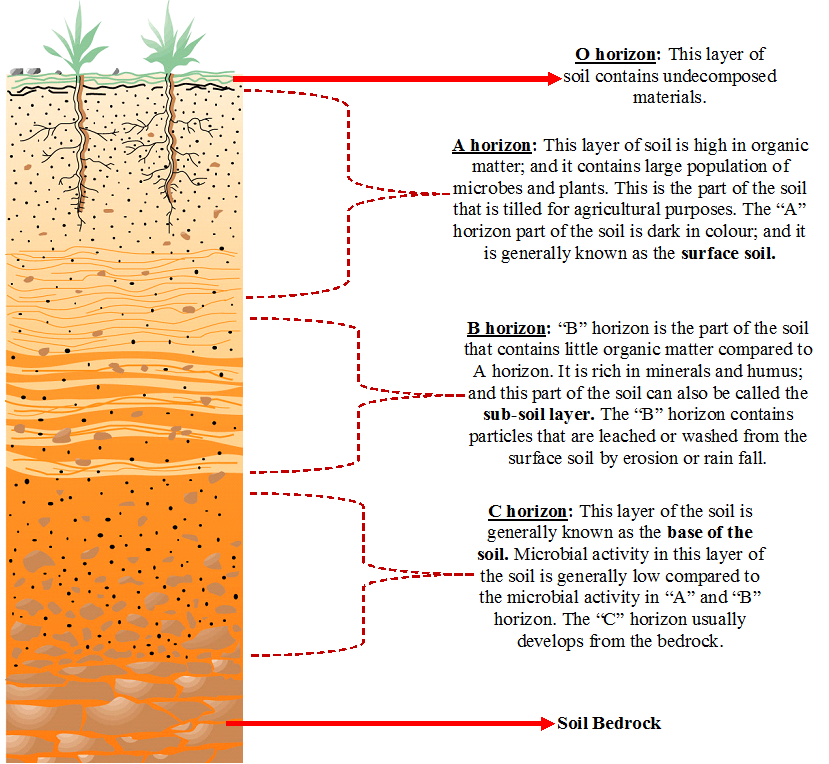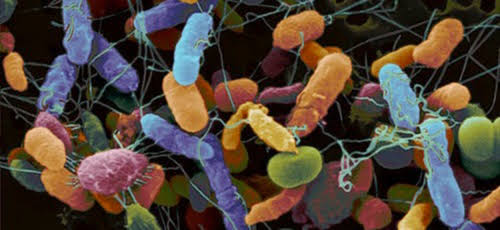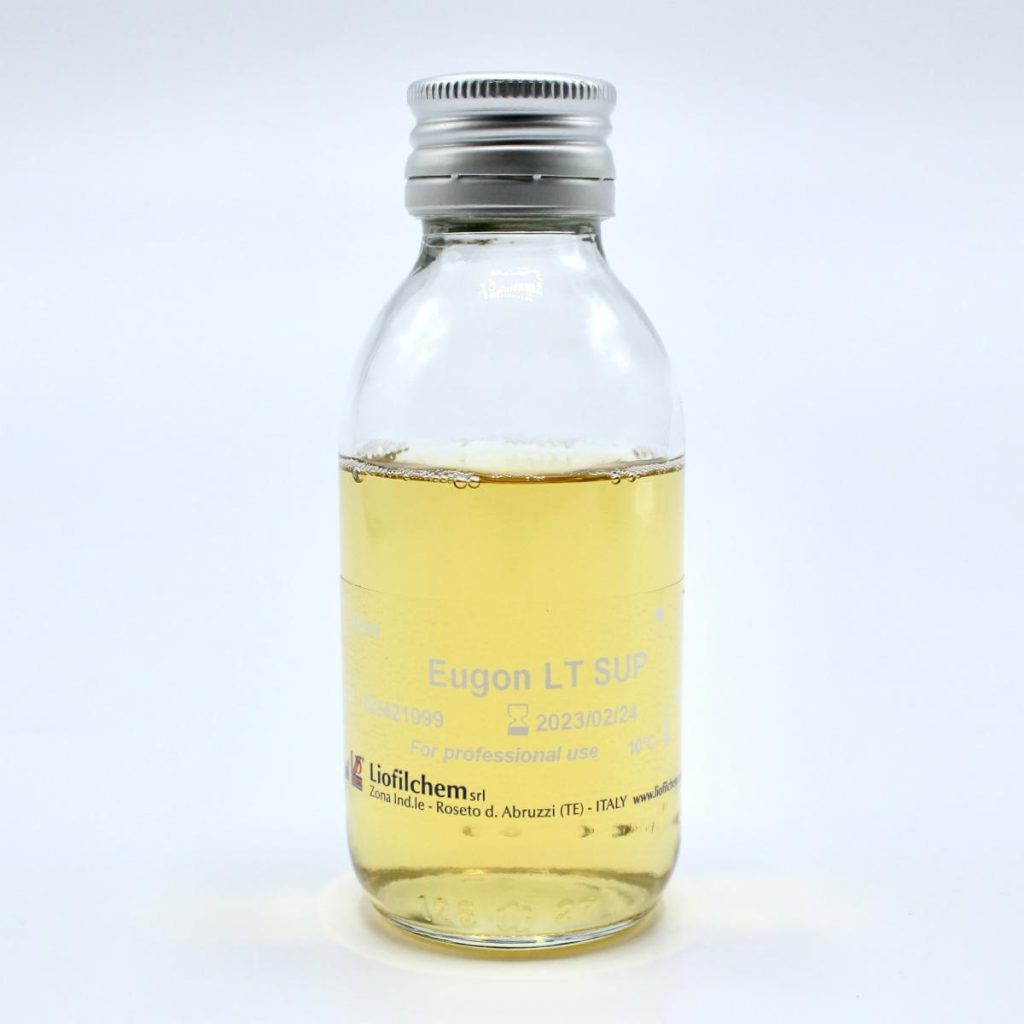Soil is simply defined as the mixture of minerals, organic matter, gases, liquids, and the countless macroscopic and microscopic organisms that together support life on the earth’s crust (lithosphere). It is the most abundant ecosystem on earth. Soil develops as a result of the weathering of geological rock formations in the earth’s crust. Soil usually consists of mineral particles derived from the eroded rocks and of organic matter derived from the remains of plants, animals, and microorganisms. Soil is a major component of the earth’s ecosystem; and soil is a habitat for a wide variety of soil organisms.
The soil is a medium for plant growth; and it offer plants the necessary physical support, air, water, temperature moderation, nutrients, and protection from toxins. Soil also provides readily available nutrients to plants and animals by converting dead organic matter into various nutrient forms. The soil represents a favourable habitat for microorganisms and is inhabited by a wide range of microorganisms, including bacteria, fungi, algae, viruses and protozoa.
The ecological significance of soil microorganisms is limitless; and though these organisms form only a fraction (less than one percent) of the total soil mass, they play important role in supporting plant communities on the earth surface. Many antibiotic-producing microorganisms (inclusive of bacteria and fungi) are mainly found in the soil; and several other microbes (e.g. Nitrosomonas species) that improve the fertility of the soil and aid in the improvement and development of plants or crops are also found in the soil. Soil microorganisms are very important as almost every chemical transformation taking place in the soil involves active contributions from soil microorganisms including bacteria, fungi, protozoa and algae.
Soil microorganisms actively take part in the biogeochemical cycling of nutrients including carbon, sulphur, nitrogen, iron and phosphorus. Nitrogen-fixing bacteria found in the soil transform nitrogen gas present in the soil atmosphere into soluble or usable nitrogenous compounds such as nitrates and ammonium that plant roots can utilize for their optimal growth; and certain soil microorganisms such as the mycorrhizal fungi can also increase the availability of mineral nutrients such as phosphorus to plants.
Soil microbes have a lot to do with maintaining good soil structure, which promotes infiltration and drainage of water, soil aeration, and vigorous root growth and exploration. Soil microbes plays important role in the process of decomposition of organic matter and release of plant nutrients in soil. Soil bacteria, fungi and actinomycetes help to degrade hydrocarbons including waxes, paraffin’s, and oils in the soil. Also in the soil are found some pathogenic soil microorganisms that cause disease in plants and thus affects or damage crops. Soil is divided into different segments or horizons based on their content of organic matter, soil microorganisms and the texture of the soil.
Some soil horizons will have high hydraulic conductivities and thus have greater and more rapid fluctuations in soil moisture while some soil horizons will have greater bulk densities with lower effective porosities and thus have lower saturation values. Other soil horizons have clay films that will retain water at field capacity longer than other soil horizons. Soil horizons are distinct layers of soil that form naturally in undisturbed soil over time (Figure 1). The texture of a soil usually refers to the different sizes of mineral components or particles in a given soil sample; and the different layers or parts of soil support different types of microorganisms and macroscopic organisms.

There are different types of soil but clay, loamy and sandy soils are the most common types of soil used for varying agricultural properties.
- Loamy soil: Loamy soil is dark in colour and it is soft, dry and crumbly in the hand. It contains a balance of all the three types of soil materials including silt, sand and clay that make up silty soil, sandy soil and clay soil respectively. Loamy soil contains humus – which is lacking in clay, silt and sandy soil. It has a higher pH and calcium levels because of its high content of organic matter. Loamy soil is the best type of soil for agriculture because of its high content of humus.
- Clay soil: Clay soils are tinier than sandy soil and they bind easily with water and plant nutrients. Clay soil has a good water retention capacity. The particles found in clay soil are very small and compact; and clay soil absorbs and holds water and creates a drainage problem in the soil. The ability of clay soil to hold water adversely affects the health of plant and its growth. Clay soil has the smallest particles among the three types of soil.
- Sandy soil: Sandy soil contains large particles of sand which determine its drainage and aeration capacity. It is the most loose-type of soil. The water and nutrients (particularly nitrogen) quickly drain away from the plant root zone in sandy soil because they have a poor-water-retention capacity. Sandy soil has the largest particles among the different soil types. It is dry and gritty to the touch.
- Silt soil: Silt (silty) soil is made up of fine particles. And like clay soil, silt soil holds water but it does not have good aeration around the plant roots. Silty soil has much smaller particles than sandy soil; and so it is smooth to the touch just like sandy soil. Several natural and human factors or activities affect the composition and fertility of the soil. Some of these factors that have negative impact on the soil include erosion, loss of organic matter, compaction, salinisation, landslides, and contaminationfrom non-biodegradable human wastes.
References
Abrahams P.W (2006). Soil, geography and human disease: a critical review of the importance of medical cartography. Progress in Physical Geography, 30:490-512.
Ahring B.K, Angelidaki I and Johansen K (1992). Anaerobic treatment of manure together with industrial waste. Water Sci. Technol, 30, 241–249.
Andersson L and Rydberg L (1988). Trends in nutrient and oxygen conditions within the Kattegat: effects on local nutrient supply. Estuar. Coast. Shelf Sci, 26:559–579.
Ballantyne A.P, Alden C.B, Miller J.B, Tans P.P and White J.W.C (2012). Increase in observed net carbon dioxide uptake by land and oceans during the past 50 years. Nature, 488: 70-72.
Baumgardner D.J (2012). Soil-related bacterial and fungal infections. J Am Board Fam Med, 25:734-744.
Bennett E.M, Carpenter S.R and Caraco N.F (2001). Human impact on erodable phosphorus and eutrophication: a global perspective. BioScience, 51:227–234.
Bunting B.T. and Lundberg J (1995). The humus profile-concept, class and reality. Geoderma, 40:17–36.
Chang S.T (2006). The world mushroom industry: trends and technological development. International J. Medicinal Mushrooms, 8:297-314.
Jee C and Shagufta (2007). Environmental Biotechnology. APH Publishing Corporation, Darya Ganj, New Delhi, India.
Maier R.M, Pepper I.L. and Gerba C.P (2000). Environmental Microbiology. Academic Press, San Diego.
Miguel A, Manuel F, Francisco J.P and Antonio B (2006). Environmental biocatalysis: from remediation with enzymes to novel green processes. TRENDS in Biotechnology, 24(6):1-7.
Mishra B.B, Nanda D.R and Dave S.R (2009). Environmental Microbiology. First edition. APH Publishing Corporation, Ansari Road, Darya Ganj, New Delhi, India.
Paul E.A (2007). Soil Microbiology, ecology and biochemistry. 3rd edition. Oxford: Elsevier Publications, New York.
Pelczar M.J Jr, Chan E.C.S, Krieg N.R (1993). Microbiology: Concepts and Applications. McGraw-Hill, USA.
Pelczar M.J., Chan E.C.S. and Krieg N.R. (2003). Microbiology of Soil. Microbiology, 5th Edition. Tata McGraw-Hill Publishing Company Limited, New Delhi, India.
Pepper I.L and Gerba C.P (2005). Environmental Microbiology: A Laboratory Manual. Second Edition. Elsevier Academic Press, New York, USA.
Roberto P. Anitori (2012). Extremophiles: Microbiology and Biotechnology. First edition. Caister Academic Press, Norfolk, England.
Salyers A.A and Whitt D.D (2001). Microbiology: diversity, disease, and the environment. Fitzgerald Science Press Inc. Maryland, USA.
Sawyer C.N, McCarty P.L and Parkin G.F (2003). Chemistry for Environmental Engineering and Science (5th ed.). McGraw-Hill Publishers, New York, USA.
Ulrich A and Becker R (2006). Soil parent material is a key determinant of the bacterial community structure in arable soils. FEMS Microbiol Ecol, 56(3):430–443.
Discover more from #1 Microbiology Resource Hub
Subscribe to get the latest posts to your email.



